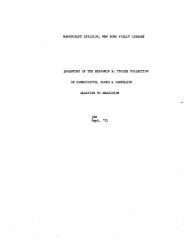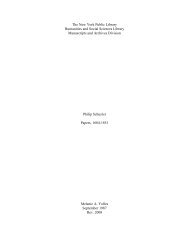pdf available - Multiple Choices
pdf available - Multiple Choices
pdf available - Multiple Choices
Create successful ePaper yourself
Turn your PDF publications into a flip-book with our unique Google optimized e-Paper software.
the end of Friday evening services in the synagogue<br />
and the congregation was invited to come<br />
to the home, after they had their dinners, for a<br />
Shalom Zachar. At tables set with baked goods<br />
and liquor, and particularly with cooked<br />
chickpeas seasoned with pepper and salt (arbes,in<br />
Yiddish) and with various kinds of drinkssoft<br />
and hardthe assembled guests would sing and<br />
discuss Torah on the happy occasion.<br />
On all eight days leading up to the circumcision,<br />
the little children whose schoolroom was<br />
closest to the home where the baby was born,<br />
accompanied by the rebbe's helper (the behelferor<br />
sometimes belfer) would come to the bedside<br />
an d read prayers, including the Sh'ma and<br />
HaMalach HaGoel Mikol Ra, and as payment for<br />
their pains they were given a handful of candies<br />
and nuts.<br />
The circumcision, naturally, was performed<br />
at home, and the skin was wrapped in a cloth and<br />
put in a box of sand in the Great Synagogue. It<br />
was customary to nurse the child for a long time,<br />
and if the mother did not have enough milk, or it<br />
stopped too soon, a wetnurse would be hired.<br />
Until the child learned to stand up and walk,<br />
he was kept mostly in his crib, a boat-shaped<br />
little basket woven of shoots and strung to the<br />
ceiling. The child slept in it and spent most of the<br />
day there, and in order to quiet him when he cried<br />
or to get him to go to sleep, the cradle was rocked<br />
like a swing.<br />
The birthrate was generally high, but the<br />
mortality rate was also high.<br />
The Cheder<br />
When a boy reached the age of three, he was<br />
already sent to the cheder [school], to the nearest<br />
teacher for small children. I remember very well<br />
my first day in cheder with the rebbe R. Yisroel,<br />
who lived across the street; I was brought there<br />
wearing my father's taus [prayer shawl], carried<br />
by the young behelfer, while my mother and grandmother<br />
shed tears of joy and happiness.<br />
The first things we learned were the letters of<br />
the Hebrew alphabetkometz alef, awin order<br />
to become familiar with letters and vowels. Then<br />
they taught us all the particulars necessary to be<br />
able to read the Siddur easily. This was our only<br />
THE EARLY DAYS 53<br />
textbook until gradually we progressed to the<br />
Chumash [Pentateuch].<br />
The occasion marking the beginning of the<br />
study of the Chumash usually took place at home<br />
among family members on a Sabbath, when the<br />
rebbe would come to talk about the pupil's<br />
progress. A diligent student would give a small<br />
talk on a timely topic, which had set formulations.<br />
One began as follows: "I have auspiciously<br />
begun to study Chumash: Chumash means `five'<br />
the five books of the Torah"and here the candidate<br />
would begin reciting the names of the books<br />
in order, with the help of the five fingers on his<br />
hand, explaining their contents.<br />
Another formulation was: "Rav Ashi said:<br />
'Why do the children begin with study of Leviticus,<br />
telling of the sacrifices [in the Temple] and not<br />
with the book of Genesis [the beginning of the<br />
Torah]?' It is because we, the small children, are<br />
like a pure sacrifice," etc.<br />
Studying the commentary of Rashi, with its<br />
characteristic script, was a middle stage and a<br />
transition to the start of studying Gemara with<br />
another rebbe. At age eight or nine children<br />
started to study Gemaraone lesson per week, a<br />
page or page and a half. Thursday was quiz day.<br />
The student had to read in front of the rebbe his<br />
lesson in Talmud and in the weekly Torah portion,<br />
which the rebbe had taught in the previous<br />
four days. The students always were tested in a<br />
set order, starting with the best and ending with<br />
the least capable, the one who had a "hard time<br />
understanding" and was the last in line. Any<br />
student who did not know the lesson as he was<br />
supposed to had to remain beside the rebbe's<br />
table until everyone finishedsometimes until<br />
8:00 or 9:00 in the evening.<br />
There was quite a large number of teachers<br />
for the little childrenperhaps three to five on<br />
every streetand they were especially concentrated<br />
in the alleys near the synagogue. They<br />
made a meager livingand their work was backbreaking,<br />
from morning until late at night, often<br />
including an hour or two on Sabbath afternoon.<br />
The pedagogy of those days did not forbid<br />
corporal punishment, and it was often employed<br />
in many cheders, depending on the disposition<br />
and mood of the teacher. We must give praise to







